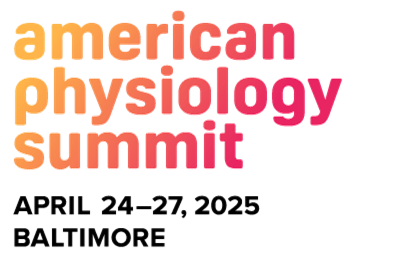Loading…

The Microcirculatory Society Pre-Meeting Sessions at the American Physiology Summit 2025
MCS Pre-Meeting Sessions: April 24, 2024 8:00 AM - 4:00 PM
American Physiology Summit Sessions: April 24, 4:00 PM - April 27, 12:30 PM
MCS Pre-Meeting Program:
Thursday, April 24 - All MCS Symposia will be held in the Hilton Baltimore Inner Harbor Hotel, Holiday Ballroom 6.
***Indicates MCS Travel Awardee.
8:00 – 9:30: Emerging Topics in Microcirculation
Chairs: Aaron J. Trask, PhD (Nationwide Children’s Hospital/Ohio State University, Columbus, OH) and Alicen Whitaker-Hilbig, PhD (Medical College of Wisconsin, Milwaukee, WI)
-
The Effects of 5-Fluorouracil Chemotherapy on Human Microvascular Endothelial Function. Stephen Hammond, Medical College of Wisconsin, Milwaukee, WI
-
Hemodynamic Characteristics of New Blood Vessel Sprouts Using High-Fidelity Red Blood Cell Resolved Simulations. Mir Md Nasim Hossain, New Jersey Institute of Technology, East Newark, NJ
-
Cardiometabolic Disease Enhances Basophil-Endothelium Interactions for Inflammation Resolution. ***Wyatt Schug, University of Virginia, Charlottesville, VA
-
The Role of Lymphatic Vessel Dysfunction in Glucocorticoid-Induced Visceral Adiposity. Jianyong Zhong, Vanderbilt University, Nashville, TN
-
Multiscale Modeling of Electromechanical Coupling and Hemodynamics in the Cerebral Microcirculation: Role of Capillary Pericytes in Blood Flow Regulation. Nikolaos Tsoukias, Florida International University, Miami, FL
-
Fibulin-5-β1 Integrin Interaction and RhoA Kinase Signaling Regulate Mesenteric Artery Constriction. Michelle Lin, Washington University, St. Louis, MO
15-minute break
9:45 AM - 11:15 AM: Gabor Kaley Award Featured Topic: Highlights of Microcirculation in Aging, Cardiovascular and Metabolic Diseases
Chairs: Bina Joe, PhD, Charles Thodeti, PhD and Osman, Islam, PhD, Department of Physiology and Pharmacology, The University of Toledo, Toledo, OH
-
Image-based “Neurosurveillance” Reveals How Seizures Disrupt the Brain’s Microcirculation. Janaka Senarathna, Department of Radiology and Radiological Science, Johns Hopkins University
-
Induction of Senescence by Overexpression of p16 Promotes Human Microvascular Endothelial Dysfunction. ***Rachel Limpert, Department of Physiology and Department of Anesthesiology, Medical College of Wisconsin
-
Mechanosensitive ion channel TRPV4 modulates endothelial autophagy and angiogenesis through the YAP/AMPK/mTOR pathway. Venkatesh Katari, Department of Physiology and Pharmacology, University of Toledo
-
Pericytes in cardiac Electro-Metabolic Signaling. Guiling Zhao, University of Maryland School of Medicine, Baltimore
-
Neuraminidase-3 Inhibition Mitigates Vascular Endothelial Dysfunction and Reduces Arterial Stiffness in Type 2 Diabetic Mice. ***Francisco Ramirez-Perez, NextGen Precision Health, University of Missouri
-
Lymphatic endothelial alpha globin regulates cardiac structure and function during cardiometabolic heart failure. ***Skylar A. Loeb, Department of Molecular Physiology and Biological Physics, University of Virginia
-
The Role of Sirtuin 6 in Regulating the Coronary Microvascular Function. Yang Wang, College of Medicine, University of Arizona
Lunch Break
12:45 PM - 2:15 PM: President’s Symposium: The Microcirculatory Society: The Next Generation
Chairs: Pooneh Bagher (University of Nebraska Medical Center) and Lauren Biwer, Yale University
-
Oxidation of LDL by hemoglobin disrupts human pulmonary microvascular endothelial barrier function. Jamie E. Meegan, PhD, Department of Physiology & Cell Biology, University of South Alabama
-
Breaking Down Cellular Stress in the Vasculature, One Long-non-coding-RNA at a Time. Cristina Espinosa-Diez, PhD, Center for Molecular Medicine and Department of Physiology, Wayne State University School of Medicine
-
Endothelial Connexin 43: Key Ca²⁺-Permeable Channels in Microvascular Function. Mauricio A. Lillo, PhD, Department of Pharmacology, Physiology, and Neuroscience, Rutgers University, New Jersey Medical School
15-minute break
2:30 PM - 4:00 PM: Trainee Flash Talks: Emerging Leaders in Microvascular Research
Chairs: Stephen Hammond, PhD (Medical College of Wisconsin), Janaka Senarathna, PhD (Johns Hopkins University), and Galina Mironova, PhD (University of Western Ontario)
-
Cholesterol Insensitive Kir2.1 is Protective Against Obesity as a Result of Improved Endothelial Function in Resistance Arteries. Katie Beverley, Ph.D., Department of Medicine, University of Illinois-Chicago
-
A novel role for tryptophan and indoleamine 2,3 dioxygenase in human blood vessels. ***Michelle Broekhuizen, Ph.D., Department of Medicine, Medical College of Wisconsin
-
Longitudinal capillary heterogeneity: Implications for active hyperaemia. Mackenzie Charter, Department of Human Health and Nutritional Sciences, University of Guelph
-
Intermittent hypoxia associated with obstructive sleep apnea disrupts microvasculature networks in the mouse retina. Fazle Elahi, PhD, Department of Medical Pharmacology and Physiology, University of Missouri
-
Impact of chronic neuroendocrine stress on cerebrovascular architecture and astrocyte morphology. Jenan Husain, Department of Pharmacology, University of Vermont
-
The essential role of transglutaminase 2 in the cytoskeletal responses of vascular smooth muscle cells to mechanical stretching. ***Olubodun Lateef, Department of Medical Pharmacology and Physiology, University of Missouri
-
Adiponectin is a critical regulator of flow-mediated vasodilation in resistance arterioles of skeletal muscle. Steven Medarev, Florida State University
-
An Image-informed Computational Model for Predicting Spatiotemporal Variations in Cerebral Blood Flow. ***Rebeca Oliveira, Johns Hopkins University
-
Alzheimer’s Disease Augments Cerebrovascular Apoptosis to Oxidative Stress in Males and Females at Different Stages of Diseases Progression. ***Safa, Department of Medical Pharmacology and Physiology, University of Missouri
-
Regional heterogeneity of vascular reactivity along the aorta: consideration of sex as a biological variable. ***Timothy Sveeggen, Department of Cellular and Integrative Physiology, University of Nebraska Medical Center
-
Reduced Cutaneous Nitric Oxide-Mediated Vasodilation of the Microvasculature in the Paretic Leg of Individuals Post-Stroke. Alicen Whitaker-Hilbig, DPT, PhD, Department of Physical Medicine and Rehabilitation, Medical College of Wisconsin
-
Development of an experimentally derived microscale blood and lymphatic vasculature model for applications to radiopharmaceutical dosimetry. Julia Withrow, J Crayton Pruitt Family Department of Biomedical Engineering, University of Florida

